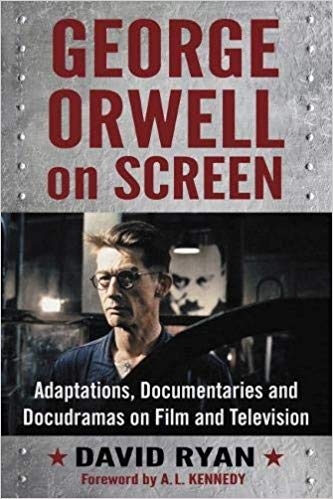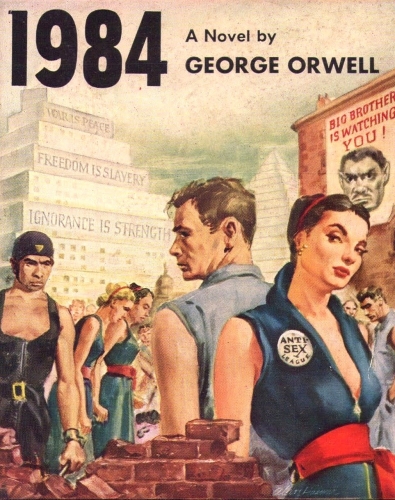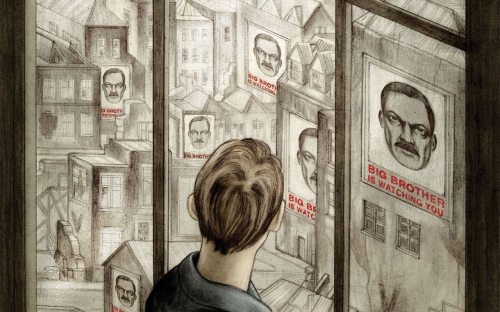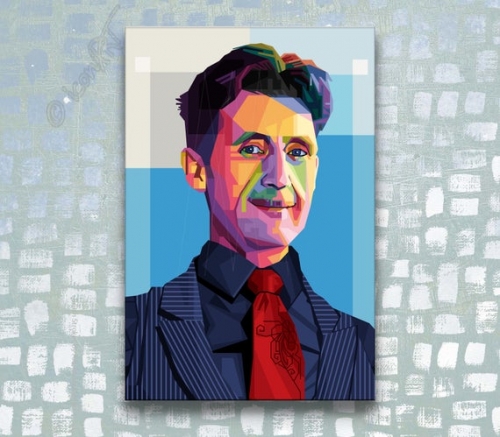David Ryan
George Orwell on Screen
Jefferson, N.C.: McFarland & Company, 2018
This book took me down a rabbit hole when I discovered it last June. For several days I didn’t want to do anything but watch old television dramatizations and documentaries about George Orwell’s works and life. There have been a surprising number of them, and most of the key ones can be found online or in other digital media. A few, alas, have vanished into the ether, and we have to make do with David Ryan’s script synopses.
 To his credit, Ryan does not spend much ink on critical analyses of the various presentations. That would make for a very fat and dreary book. In nearly every instance he’d have to tell us that the production was uneven and woefully miscast. I wondered if he was going to carp about the misconceived film adaptation of Keep the Aspidistra Flying (1997; American title: A Merry War). Not a bit of it; he leaves it to us to do the carping and ridicule. What he does provide is a rich concordance of Orwell presentations over the years, with often amazing production notes, technical details, and contemporary press notices. And if you don’t care to get that far into weeds, George Orwell on Screen is still an indispensable guidebook, pointing you to all sorts of bio-documentaries and dramatizations you might never discover on your own. This is particularly true of the many (mostly) BBC docos produced forty or fifty years ago, where you find such delights as Malcolm Muggeridge and Cyril Connolly lying down in tall grass and trading tales about their late, great friend.
To his credit, Ryan does not spend much ink on critical analyses of the various presentations. That would make for a very fat and dreary book. In nearly every instance he’d have to tell us that the production was uneven and woefully miscast. I wondered if he was going to carp about the misconceived film adaptation of Keep the Aspidistra Flying (1997; American title: A Merry War). Not a bit of it; he leaves it to us to do the carping and ridicule. What he does provide is a rich concordance of Orwell presentations over the years, with often amazing production notes, technical details, and contemporary press notices. And if you don’t care to get that far into weeds, George Orwell on Screen is still an indispensable guidebook, pointing you to all sorts of bio-documentaries and dramatizations you might never discover on your own. This is particularly true of the many (mostly) BBC docos produced forty or fifty years ago, where you find such delights as Malcolm Muggeridge and Cyril Connolly lying down in tall grass and trading tales about their late, great friend.
TV and film versions of Orwell’s last novel (published as Nineteen Eighty-Four in England, 1984 in America) weigh very heavily in the text, and also take up a lot of viewing time when you try to sit through them all. Among the first entries were live teleplays, one broadcast by NBC in 1953 (for the Studio One series), the other staged and broadcast twice by the BBC the following year. There was no videotape in those days, but we do have adequate if fuzzy kinescopes, recorded with a 16mm film camera aimed at a studio monitor. There were also radio adaptations in that era, including two riotous parodies by Spike Milligan and his Goon Show gang. And then, in 1956, came a big-budget feature film that was made in England but distributed under the American title 1984.
It raises some questions, this obsession with Orwell’s novel in the first half-decade or so after his death in January 1950. Was there a political motive at work, early in the Cold War? Was the book so rich in drama and human interest that everyone wanted to do it, the way all actors want to be Hamlet? I think the answer is much simpler. Live TV drama was a gaping maw that needed to be fed, and the hunger for scripts was intense, because radio drama was still very much a thing, too. (The first radio version was an American one soon after the book’s publication in 1949. It stars, incredibly enough, David Niven as a very suave-sounding Winston Smith.) Another reason for the abundance of 1984 productions might be that Orwell’s novel was that rare thing, a work of fiction that almost immediately entered common parlance, even among the many millions who never read the book. You’d have to go back to early Dickens or maybe Uncle Tom’s Cabin to find a novel with that kind of widespread impact. By 1950 anybody literate enough to read a newspaper knew who or what Big Brother was, and maybe could even appreciate jokes about “thoughtcrime” and “Room 101.”
Those two early teleplays, from NBC and the BBC, were melded together in a 1956 feature film, with Edmond O’Brien, Jan Sterling, Michael Redgrave, and Donald Pleasance (partly reprising his role from the BBC version). This version surpasses other screen adaptations in one respect: its exterior shots. It was made on location in London, and made use of recognizable landmarks and wartime bomb damage, giving us the dismal look and feel of the city in the novel. When there’s a celebration in Victory Square we don’t need to have it explained to us that this is really Trafalgar Square.
Balanced against this virtue are the movie’s oddities, and they are legion. Edmond O’Brien as Winston looks wasted and beaten-down, as Winston should, but here’s it’s as a paunchy and cirrhotic figure, rather than the gaunt and pallid nicotine addict in the book. Michael Redgrave wears a spaceship-commander uniform as the Inner Party bigwig O’Brien. Only in this movie they change his character’s name to O’Connor, because two O’Briens in the same film was thought to be too confusing for the audience.
And then there’s the problem of the finale. The novel’s finish was thought too downbeat, with Winston a broken man, drunk on clove-scented gin and separated from Julia, waiting for a bullet in the back of the head. So the director shot two different endings, one in which Julia and Winston get back together again, briefly, after which Winston finds redemption by cheering for Big Brother; and a second one in which Julia and Winston shout “Down with Big Brother” and start ripping down Big Brother posters. This “Down with Big Brother” ending is said to have been distributed in the British (and presumably European) market. I saw it on television someplace a long time ago and it was a real surprise: had I completely misremembered the ending?
* * *
Viewing the two teleplays and their mashup in the 1956 movie, one notices that, production values aside, the American “take” on the Orwell story was very different from the British one. American tastemakers conceived of 1984 as futuristic science-fiction. You see this in the lurid cover of the original Signet paperback, and in the posters for the 1956 film. The stark sets and random costumes in the 1953 Studio One production will put one in mind of something by Edward D. Wood, Jr. The designers were aiming for something like German Expressionism, but the effect is more like a cardboard dollhouse. While Big Brother posters are everywhere, “BB” is nothing like the mustachioed Stalin avatar that Orwell had in mind. Instead, “Big Brother Is Watching You” appears over a “hairless, freakishly distorted cartoon face [that] looks like something Mad magazine has commissioned from Picasso” (as author David Ryan puts it).

Speaking of Ed Wood: Lorne Greene plays a very fey O’Brien, rather like Bunny Breckinridge’s “Ruler” character in Plan Nine from Outer Space. He wears an ornate suitcoat, sort of early-Roxy-usher, to indicate his high status in the Inner Party. When he slips Winston Smith (Eddie Albert) his address and suggests they get together that evening, it looks to all the world like a homosexual assignation. And some of the costume choices suggest that the crew didn’t understand the book at all. Orwell put most of his Party members in “overalls”: meaning, the kind of onesie garment that flight mechanics would wear; like Winston Churchill’s “siren suit.” But the costume people at Studio One saw “overalls” and thought of farmers’ bib overalls. So Eddie Albert as Winston was going to go around attired in necktie and farmer overalls, foreshadowing his 1960s sitcom role in Green Acres. But it appears somebody caught the mistake at the last minute, and came up with a few grease-monkey outfits, so at least Winston and the male ensemble don’t look entirely foolish.
What I found most baffling and annoying about this 1953 NBC production is that it entirely ignores the significance of Emmanuel Goldstein in the Two Minutes’ Hate. There is no Goldstein; instead the giant telescreen shows us a beefy talking-head known as Cassandra. Perhaps the Studio One producers were chary of Goldstein’s Jewishness. Or perhaps they didn’t want to complicate things by alluding to the whole Trotsky-vs.-Stalin saga, or suggest that Orwell’s novel (author’s disclaimers notwithstanding) really truly was about Soviet Communism.
This coyness carried over into the 1956 feature film, scripted by the same scenarist, William Templeton. Once again, no Emmanuel Goldstein, no explicit suggestion of Communism per se. But this time they couldn’t call the telescreen traitor Cassandra, because in mid-1950s England “Cassandra” had a very special meaning: not the doomsayer of Ilium, but a popular, snarky columnist in the Daily Mirror. It would be like calling the Goldstein figure “Liberace.” So when the morning scrum at the Ministry of Truth gathers for their Two Minutes’ Hate, their wrath focuses upon a talking head called “the archenemy Kalador.” Kalador? Just a sci-fi-sounding name the writer or someone pulled out of the air. Inexcusable.
No such issues in the 1954 BBC teleplay. The costumers knew what “overalls” were, and the producers weren’t touchy about using the name Emmanuel Goldstein or alluding to Leon Trotsky. Here the Goldstein on the telescreen is even made up to look like Trotsky. This production is twice as long as the American one, and has sufficient time to develop minor characters and subplots. Winston Smith is played by Peter Cushing, which gives the drama something of a Hammer Horror aspect (after all, Nineteen Eighty-Four is indeed a horror tale). The real diamond in the cast, though, is young Donald Pleasance as Syme, the nerdy lexicographer who can’t stop talking about the wonders of Newspeak. In fact, I’m pretty sure he has more lines in this teleplay than he does in the book.
The BBC dramatization is also much more inventive when it comes to Room 101. NBC’s Studio One version briefly locks Eddie Albert in a cubicle with (unseen) rats. Eddie screams. Blackout. So much for the horrors of Room 101. But the BBC crew really went to town. They built a whole kludgy apparatus for the rats, involving a cage, a face mask, and a kind of plastic ventilation coil running between them (something like a supersized version of the Habitrail ducts that hamsters scamper around in). Unfortunately the rats weren’t at all fearsome or hungry when they shot this scene, so we end up with insert shots of peaceful lab rats sniffing around their cage. But you have to give the set techs an E for Effort.

The crucial difference between the 1953 American teleplay and the 1954 British one is how they approach the material. Once again, the American team thought they were doing science fiction. The British team dealt with it all as naturalistic kitchen-sink drama. This seems to me to be the only correct way to deal with Orwell. Those bedraggled Party members, sullenly putting in time at the Ministry of Truth; downing their disgusting grey stew at the canteen; maintaining themselves in a mild stupor with regular shots of cheap gin—this is pretty much wartime London as Orwell knew it and as the BBC crew remembered it. There’s very little here that’s futuristic.
Tellingly, when The Goon Show did their parody, “Nineteen Eighty-Five,” it was mainly a series of jokes about the food at Big Brother Corporation’s office canteen.
ANNOUNCER:
(over public address system) BBC workers. The canteen is now open. Lunch is ready. Doctors are standing by.
FX:
SOUND OF CANTEEN HUBBUB, CUPS & SAUCERS CLINKING
WINSTON:
As I sat at my table eating my boiled water I began to hate Big Brother Corporation.
The “naturalistic” BBC television script had a long afterlife. After being presented twice in 1954 and parodied by the Goons in 1955, it was re-produced in 1965, for a series called The World of George Orwell. And when Michael Radford made his visually stunning feature with John Hurt and Richard Burton (filmed and released in A.D. 1984), the film’s mise-en-scène recalled the fetid atmosphere of the BBC teleplays rather than the confused, big-budget 1956 movie. What’s missing in the Radford version is a clear backstory, as reflected in the novel’s atmosphere of wartime privation and squalor. This was something easy to get across in the 1954 BBC teleplay, but it doesn’t really register in the Radford version, which seems to take place in an alternative reality that exists somewhere outside our own chronological scheme.
* * *
Finding the right tone for dramatizing Orwell seems to be more of an obstacle for scriptwriters than it ought to be. Nearly everything he wrote was a depresso-gram, highly resistant to playful optimism. Earlier I mentioned Keep the Aspidistra Flying, a woeful black comedy that is set in the 1930s but follows a similar plot arc to Nineteen Eighty-Four. Somebody made a BBC teleplay of Aspidistra in the 1960s, and that seems to have been pretty faithful to the book. I.e., it was a downer. It didn’t get revived or rebroadcast, and eventually the BBC lost or erased the tapes. When the property came up again thirty years later as a feature production, the decision was made to turn it into a frothy period piece about a carefree young couple (Richard E. Grant and Helena Bonham-Carter), and that’s pretty much what we got. The idea seemed to be that the only acceptable treatment of the 1930s was something out of Masterpiece Theatre.
Two of Orwell’s best and most adaptable novels, Burmese Days and Coming Up for Air, have never gotten anywhere near feature production. The first seems to be permanently trapped in development hell, while the second was made into a BBC teleplay way back in 1965 and hasn’t been heard from since.
And then there’s Animal Farm, filmed twice but very unsatisfactorily, once in cel animation (1954) and once in live-action-plus-CGI (1999). In both instances the directors/animators missed the essential point: that this is a talking-animal tale (“A Fairy Story,” Orwell subtitled it), and the talking animals need to have distinct, developed personalities. Those personalities get lost in these films. Because in the first production the animals don’t really get to talk, the whole drama being explained in voice-over narration. The 1999 production went to the other extreme, giving us an Uncanny Valley of “real” talking barnyard animals. Instead of Orwell’s fairy-tale anthropomorphized critters, we get grotesque close-ups of drooling dogs and snot-nosed hogs. The effect is horrifying. Any sympathy we might bring to Orwell’s delightful creations doesn’t stand a chance.





 del.icio.us
del.icio.us
 Digg
Digg
Les commentaires sont fermés.